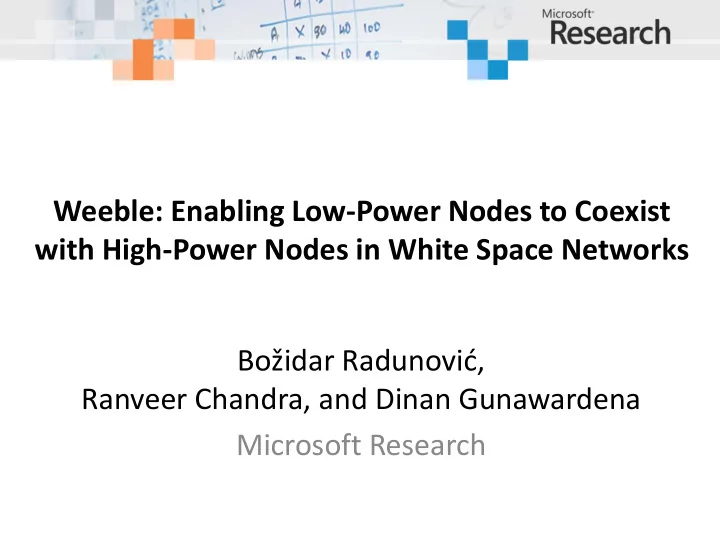

Weeble: Enabling Low-Power Nodes to Coexist with High-Power Nodes in White Space Networks Božidar Radunović , Ranveer Chandra, and Dinan Gunawardena Microsoft Research
Outline 1. Introduction 2. Weeble MAC 3. Weeble PHY 4. Evaluation 5. Summary
White-spaces • TV White spaces (TVWS) – Analogue TV frequencies free after digital swover – Good propagation characteristics • Parts offered for unlicensed use – FCC (US), Ofcom (UK), Canada, more to follow – Application • Cheap/free access (cellular offload, home) • Long-distance (rural, M2M) • Standards: 802.22 (centr.), 802.11af (CSMA)
Coexistence in 802.11af (CSMA) 4W • Two types of transmitters – 4W fixed base-stations (HP) – 100mW mobile terminals (LP) 100mW • Problem: – Carrier sense does not work – How to prevent starvation? Throughput measured in our indoor white-space test-bed
Frequency Division? • Centralized algorithm for frequency assignments: – Global and dynamic – Account for varying population and mobility – Static can be very inefficient • Now flow-level multiplexing • Unlicensed networks: – No global coordinator to mandate assignments?
Weeble • Distributed MAC protocol for coexistence • Goals: 1. Avoid starvations 2. Avoid performance degradations of long links 3. Increase total throughput • Overview: – PHY: adaptive preamble detection at low SNR – MAC: Recover CSMA using PHY detector
Outline 1. Introduction 2. Weeble MAC 3. Weeble PHY 4. Evaluation 5. Summary
Weeble MAC Overview HP2 LPR - Back-off DIFS CW L LP1 LP2 Back-off DIFS CW L LP3 Back-off CW CW DIFS
Algorithm to adapt preamble length • What preamble length to choose? – Too short: collisions – Too long: low spatial reuse • Observation: – Consecutive losses at LP likely only when a hidden HP transmits concurrently • Idea: – AIMD Adaptive algorithm based on the number of consecutive losses
Outline 1. Introduction 2. Weeble MAC 3. Weeble PHY 4. Evaluation 5. Summary
Weeble PHY Overview • Detection requirements: ~-16dB – 4W / 100mW = 16dB • Probability of detection = O(sqrt(preamb. size)) – Meet requirements by increasing preamble size • Problems: – Detection wall (due to internal noise) – Long preambles – large overhead/complexity – Long preambles – low spatial reuse – adaptation – False positives from ordinary HP transmissions
Repetitive preambles • Only detection, no time synchronization • K #repetition of mini preamble Q (K – arbitrary) • Low complexity
Adaptive Preamble Length • Correlator does not need to know K apriori – 4 parallel detector for K = {2, 6, 10, 14} – Signal detected if any of 4 output detects • Example: K = 6 K = 14 noise K = 6 signal signal signal K = 2
Outline 1. Introduction 2. Weeble MAC 3. Weeble PHY 4. Evaluation 5. Summary
Evaluation • Implemented on Lyrtech SDR – MAC in DSP, PHY in FPGA • Large-scale simulation in Qualnet • Test-bed: – Across 3 floors – 2 HP nodes – 2 LP nodes (different locations) Office building
PHY Measurements Median location will have 80% accuracy for K=10 and 90% accuracy for K=14 at SNR = -16.5 dB – Measure probability of misdetection of packet batch at different locations – Plot CDF across locations SNR = -16.5 dB
Weeble in Action
Fairness vs. Efficiency Fairness Efficiency • Starved flow = TCP flow with rate ≤ 100 kbps
Outline 1. Introduction 2. Weeble MAC 3. Weeble PHY 4. Evaluation 5. Summary
Weeble Summary • We consider coexistence problem in 802.11af • Weeble PHY: – Little extra logic/silicon – Use adaptive preambles to avoid starvation while maximizing spatial reuse and minimizing overhead – Use L and H preamble to avoid false positives • Weeble MAC: – Distributed, contention based MAC – Algorithm for adapting preamble lengths
THANK YOU!
Recommend
More recommend